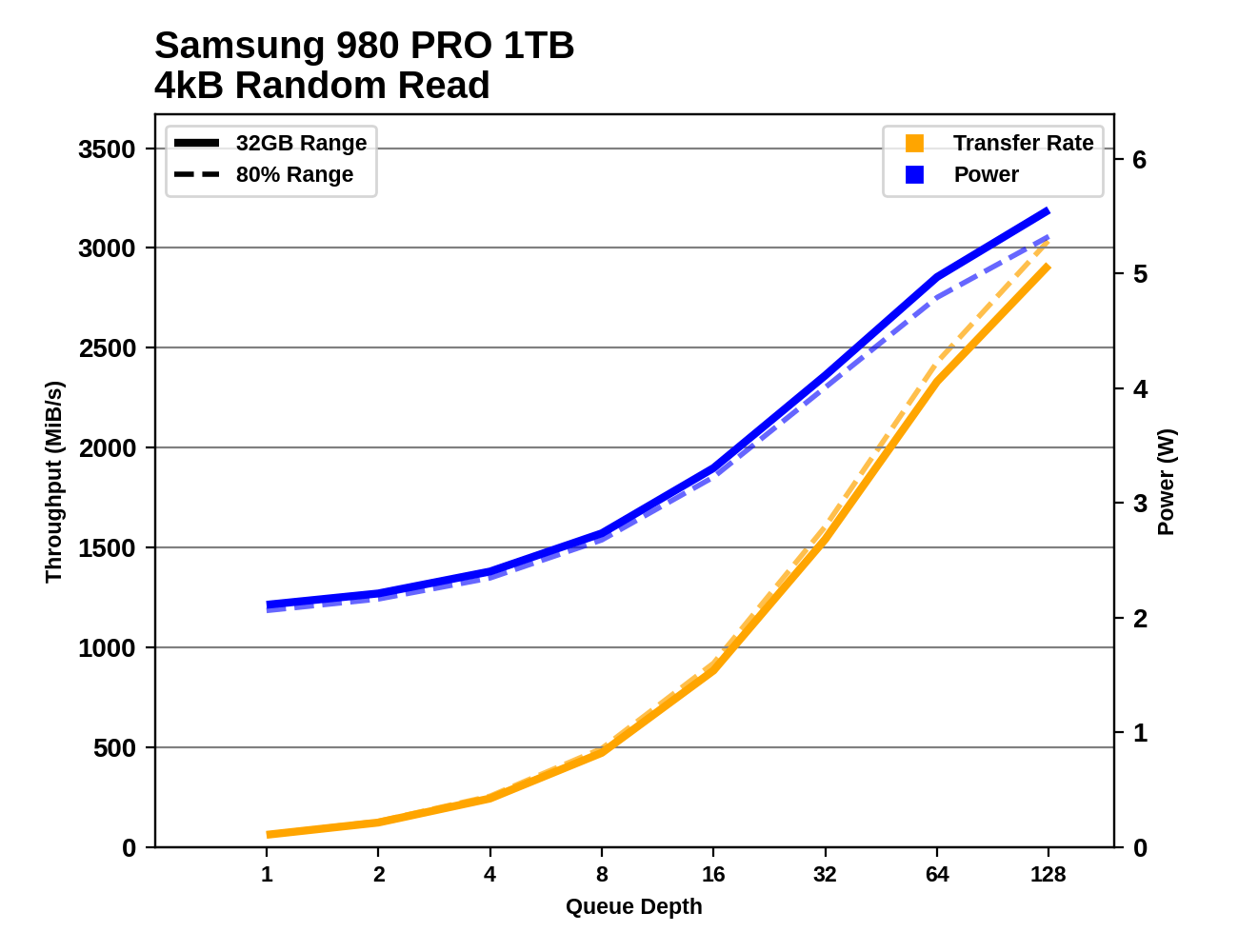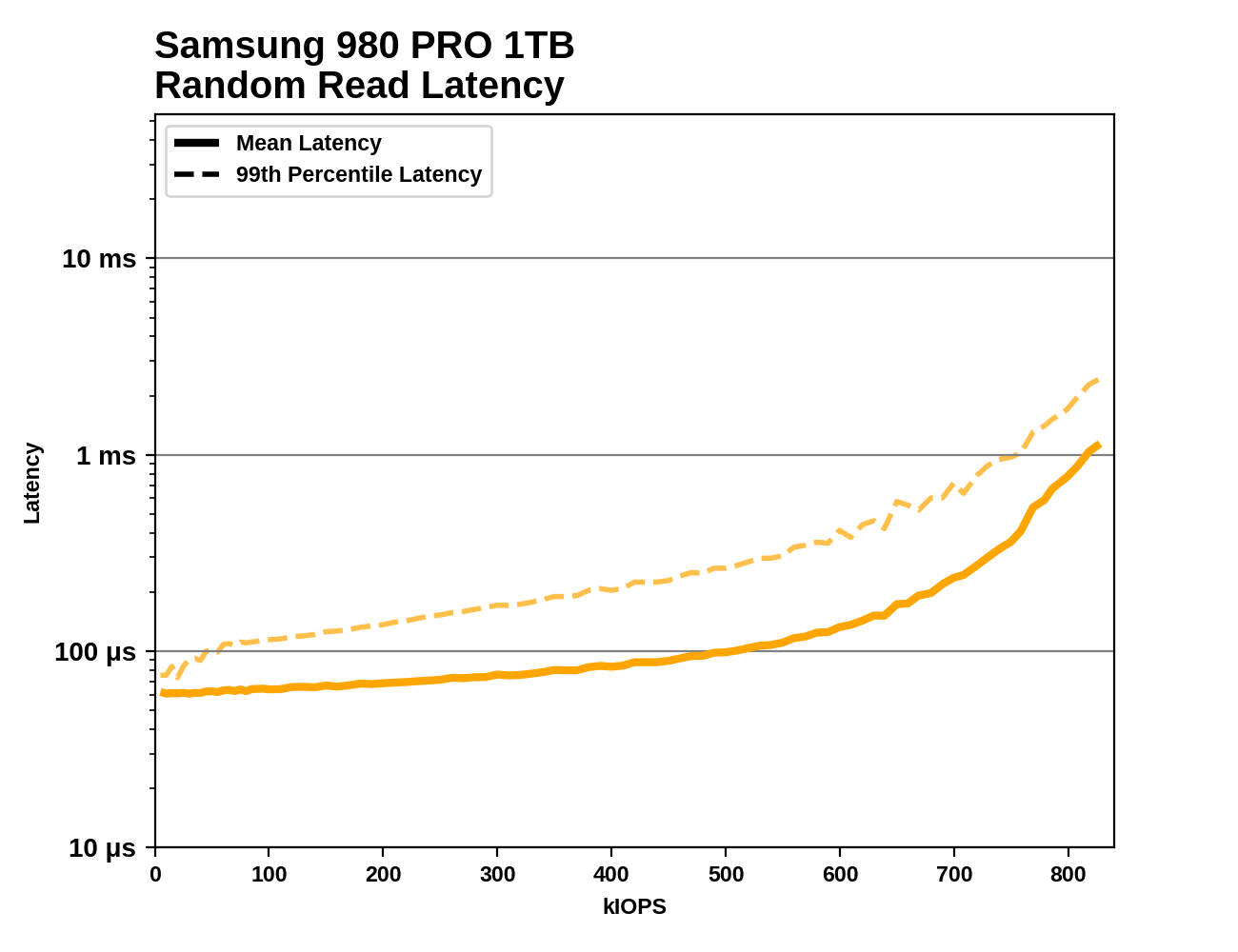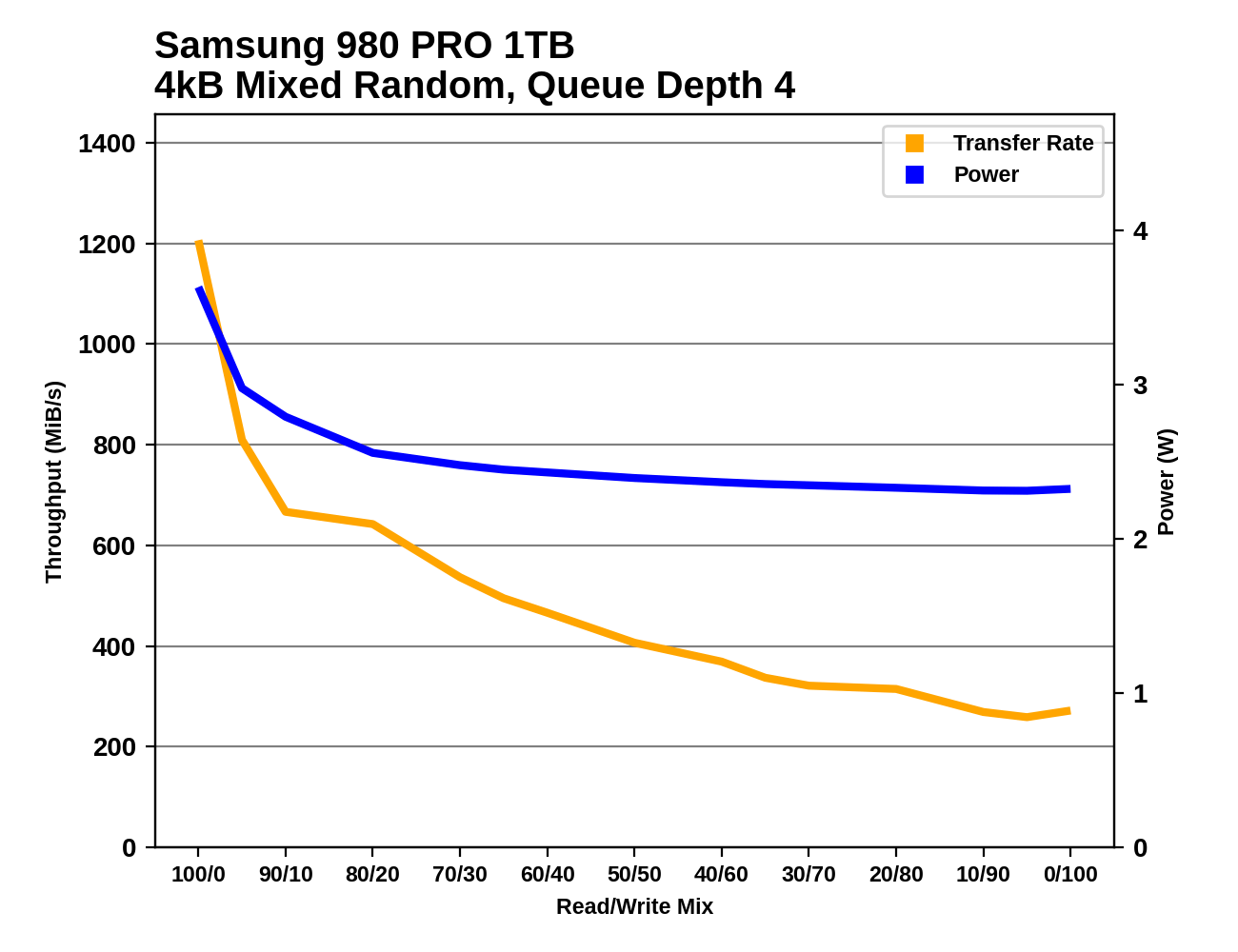How We Test PCIe 4.0 Storage: The AnandTech 2021 SSD Benchmark Suite
by Billy Tallis on February 1, 2021 1:15 PM ESTSynthetic Tests: Basic IO Patterns
Our first batch of synthetic benchmarks exercise the four basic IO patterns: random reads, random writes, sequential reads, and sequential writes. These are the figures most often quoted on SSD spec sheets, with the fine print delineating test conditions designed to produce the largest possible numbers. Our tests are intended to reflect more realistic conditions of low queue depths, though we do also include some tests that get up to very high queue depths.
The biggest change here from our previous SSD test suite is that all of these tests are now run twice: first on a mostly-empty drive with the test confined to the first 32GB of the drive, and later with the drive 80% full and the test allowed to touch any part of that 80%. The intention here is to capture some of the impact of SLC caching and DRAMless or reduced-DRAM designs. The test runs given free reign over 80% of the drive will show much less spatial locality than the 32GB range runs, so drives that do not have a full-size DRAM buffer to cache their FTL mapping tables will generally show worse random access performance for the wide-range tests. Running tests with the drive 80% full also means drives with a variable-size SLC cache will have had to shrink the cache size down to its minimum size (or very nearly), which means write tests will be much more likely to overflow what SLC cache remains. Drives that optimistically keep data in their SLC caches to accelerate reads will also tend to suffer on the wide-range tests where most of the data accessed cannot still be in the cache.
Burst IO Performance
First up, we have a series of tests at queue depth 1 measuring performance on short bursts of IO. The random read and write tests consist of 32 bursts of up to 64MB each. The sequential read and write tests use eight bursts of up to 128MB each. Each burst is limited to a maximum of one second, though that limit should only come into play for particularly slow drives.
Contrary to standard industry practice, these sequential read and write test are configured to perform 1MB operations rather than 128kB. We made this choice because disk traces show that the sequential IO produced by moving large files around with Windows results in 1MB chunks of IO, so these burst sequential IO tests are a decent proxy for simple file copying tests, and are somewhat more representative of real-world IO patterns than issuing 128kB requests one at a time. However, since these tests are run on Linux, the OS will split up these IOs into 128kB segments and issue them to the drive as a batch of 8 commands, although that doesn't much change the chunkiness of the IO. This change to 1 MB is likely to particularly benefit drives optimized for 1 MB chunks, and we've previously noticed a number of popular controllers focusing on this size for IO, despite most spec sheets only focusing on 128 kB.
 |
|||||||||
| Random Read | Random Write | ||||||||
| Sequential Read | Sequential Write | ||||||||
Sustained IO Performance
Our sustained IO tests have also changed a bit, aside from the split to test both narrow and wide ranges of the drive. We're still testing the four basic IO patterns at a range of queue depths (now going up to QD128), but placing the most importance on performance at the low queue depth most commonly produced by real-world usage.
Each sub-test is permitted to run for much longer than our burst IO tests, but we still place strict limits on these tests: the test for each queue depth and IO pattern is allowed to transfer up to 16GB, and to run for no more than 30 seconds (sequential IO) or 10 seconds (random IO). After each test that only reads data, the drive is given idle time equal to the duration of the test phase that just completed. After tests that write data, the idle time is five times longer, to allow for the drive's background cleanup processes to make progress. The random read and write tests are multithreaded and will use up to four threads to perform IO, so the QD32 test phase consists of four threads each operating at QD8. The sequential IO tests are all single-threaded regardless of queue depth, and move to a new random location within the test range after each 128MB of IO, in order to avoid constantly hammering the same LBAs on each iteration. (This can be thought of as representing a mild degree of filesystem fragmentation.)
Since these tests run longer than the blink of an eye durations of the burst IO tests, we're able to take meaningful power measurements, and compute power efficiency metrics (performance per Watt) for each test.
The primary scores we report for each test are an average of the measured performance/power/efficiency at queue depths 1, 2 and 4. Weighting those three equally is a fairly arbitrary choice, but we feel it does a fine job of representing a somewhat realistic distribution of queue depths.
 |
|||||||||
| Random Read: | Performance | Power | Efficiency | ||||||
| Random Write: | Performance | Power | Efficiency | ||||||
| Sequential Read: | Performance | Power | Efficiency | ||||||
| Sequential Write: | Performance | Power | Efficiency | ||||||
 |
|||||||||
| Random Read | |||||||||
| Random Write | |||||||||
| Sequential Read | |||||||||
| Sequential Write | |||||||||
Digging into the detailed graphs for each drive shows that the latest high-end NVMe SSDs continue to show increased performance as queue depths climb to insane levels. We could have extended these tests far beyond QD128, but we're already well into the fantasy realm of silly benchmarks. There are also some very striking discrepancies between the narrow 32GB range testing and the 80% full drive testing, especially on the write tests.
Random Read Performance Consistency
Next up is a test borrowed from our enterprise SSD benchmark suite. This test is designed to measure the latency and performance consistency of a drive during sustained random reads. Measuring latency during our other sustained IO tests can produce misleading scores because those tests run at specific fixed queue depths. There are two main problems with this approach. First, if the queue depth is higher than what's necessary to get full performance out of the drive, then every operation will have to wait in the queue for some time before the drive starts working on it. That inflates all the latency metrics by an amount proportional to how much larger the queue depth is than necessary for that particular drive.
The second problem is a bit more subtle. In the real world, new IO requests don't stop showing up just because the drive already has eg. four or eight requests already pending, and if a drive stalls while handling one particular request, new IO commands will build up in the queue. A test that runs at a fixed queue depth will only record a handful of high-latency operations during a performance stall; this is called the coordinated omission problem. The solution is a test that issues IOs at a fixed rate, and lets queue depth be a consequence of the drive's performance.
This test issues 4kB random reads at increasing rates until the drive can't keep up. At each rate tested, the test performs 4GB of random reads (split across 4 threads), for a total of just over a million IOs. We report the average and 99th percentile latency at each rate, starting from 5k IOPS and increasing until the drive cannot sustain the requested rate. This test doesn't include any idle time between steps, so toward the end it is considerably more intense than real-world consumer workloads.
This test is only performed for random reads. Sequential reads and writes are usually not so latency-sensitive for consumer workloads: either the software only cares about when the entire sequential transfer is done, or it's streaming data and the application or OS can perform buffering and prefetching in RAM. Random writes can also be buffered in RAM, and SLC caching would give this test messy results on most consumer drives.
 |
|||||||||
Most drives show a gradual increase in latency that becomes much steeper as the test approaches the drive's maximum throughput. The testing doesn't cut off until the drive is delivering at least 5% less than the requested rate, but we cut the graphs off a bit earlier than that: stopping at the last step before the drive's actual (rather than requested) performance is within 1% of its true maximum throughput. Without trimming off the end of the curve, basically every drive's graph would end in a vertical line that distorts the scale of the graph.
Occasionally a drive's performance Quality of Service (QoS) will be bad enough that it fails out of the test early, long before its theoretical throughput limit has been reached. That would be a serious concern for an enterprise drive, but for consumer drives it's only an issue if it happens very early in the test at low speeds. Typical real-world consumer workloads don't produce an uninterrupted stream of random reads like this test, and when a consumer SSD has QoS problems it's usually because some slow write operations are getting in the way of read operations.
Mixed IO Performance
The trace-based tests in our benchmark suite do a pretty good job of covering realistic patterns of mixed reads and writes. These synthetic tests of varying mixes of reads and writes aren't intended to emulate any particular real-world usage, but are more about observing how performance scales as the balance between reads and writes is adjusted. Most consumer IO tends to involve more reads than writes, but these benchmarks test read-heavy and write-heavy workloads equally.
The changes to our synthetic tests of mixed read/write workloads are similar to the modifications for the other sustained IO tests. However, on this one we're not bothering to split it into versions running against a 32GB slice of the drive and an 80% full drive: the only versions here are the 80% full tests.
Both the mixed sequential and mixed random IO tests use four threads each running at QD1, for a total queue depth of 4. The mixed sequential IO test has been switched to use 1MB operations rather than 128kB, which means there's considerably more data in flight than our old 128kB @ QD1 mixed sequential IO test.
Each workload mix is tested for at most 10 seconds/16GB (random IO) or 30 seconds/16GB (sequential IO). The main scores reported here are averages across all the mixes tested. A good score usually indicates a well-rounded drive that handles write pressure well, but a poor score here doesn't necessarily translate into anything worth worrying about for a consumer.
 |
|||||||||
| Mixed Random IO: | Performance | Power | Efficiency | ||||||
| Mixed Sequential IO: | Performance | Power | Efficiency | ||||||
 |
|||||||||
| Mixed Random IO | |||||||||
| Mixed Sequential IO | |||||||||










70 Comments
View All Comments
drmaddogs - Saturday, June 19, 2021 - link
Random is measured by Chaos measures. Turing had it best. And AI mimics this like the human brain.pexxie - Friday, February 12, 2021 - link
I was hoping to hear more from the linux fundi. :-(I guess criticism is easy, guidance takes effort. :-P
pexxie - Saturday, February 13, 2021 - link
An alternative to this might be a retention or volatility test. So basically hook the SSD up in a way that you can quickly yank out its sata or power cable. Then copy a very big file to it, and immediately after Windows says the copy is done; yank out the data or power cable. Then reboot and do a checksum on the file on the target SSD, and compare to the original, and see if any of them have actually written all the data.pexxie - Saturday, February 13, 2021 - link
I wish we could edit posts. Grrr.Otherwise if it's an M.2 slot; hit the reset button on the PC immediately after Windows says the file has finished copying. Then compare checksums.
pexxie - Saturday, February 13, 2021 - link
So basically testing power loss resiliency. There in the 1st world power reliability is of no concern, but it's a big concern here in the 3rd world. Power aint reliable like in America.pexxie - Saturday, February 13, 2021 - link
You can observe the disk's misconduct with the disk LED on your chassis. The disk LED should stop when the file copy is done, but it doesn't - so it still takes time for it to get it onto non-volatile storage. So the data is still floating around in volatile memory while that LED is still on. I have 4 SSDs - for one of them the LED only stays on like a second after the file copy is "done." The others take 5-ish seconds. They all fail in a power cut test - killing power immediately after the OS says the copy is "done." Checked in Windows and Linux. I suspected this was misconduct by Windows, but since I see it in linux too; I'm more confident about it being disk misconduct.pexxie - Saturday, February 13, 2021 - link
My bad. Actually this LED thing was because of buffered writes by the OS. Using xcopy in windows with the /J parameter avoids this "misconduct." So it is actually the OS behaving badly. Now to just figure out how to force all writes to be unbuffered....Even using unbuffered writing; my SSDs still fail my power cut test - parts of the file sit in volatile memory for too long after the copy is "done" and the file gets corrupted on the destination disk.
pexxie - Sunday, February 14, 2021 - link
Woohoo! Finally solved this by mounting partitions in linux using the "sync" option. I knew TLC chips were insanely slow, but damn - less than 1MB/s sequential writing is madness. At least I'm getting 10MB/s sequential with my old MLC chips. So it was the doing of the OS all long. Multiple layers of caching make a tortoise storage medium look like a rabbit.Won't add any more posts/spam. Just wish I could consolidate into 1.
kpb321 - Monday, February 1, 2021 - link
How is the AMD Ryzen 5 3600X system being run without a GPU? That chip doesn't have integrated video so generally I expect it would fail at Post with beep codes. AFAIK none of the AMD APUs have PCI-E 4 support so I don't think there is a way to use integrated video and support PCI-E 4. I mean it doesn't need much of a video card and the 580 in the other system is probably overkill for storage testing but it seems like it would need something even if it's installed in one of the PCI-e 3 lanes hanging off the chipset instead of the 4.0 lane off the cpu.frbeckenbauer - Monday, February 1, 2021 - link
You can run Ryzen headless without issues on many motherboards, while some will indeed refuse to boot. MSI apparently provides a BIOS that has the error disabled so it works headless if you ask them.